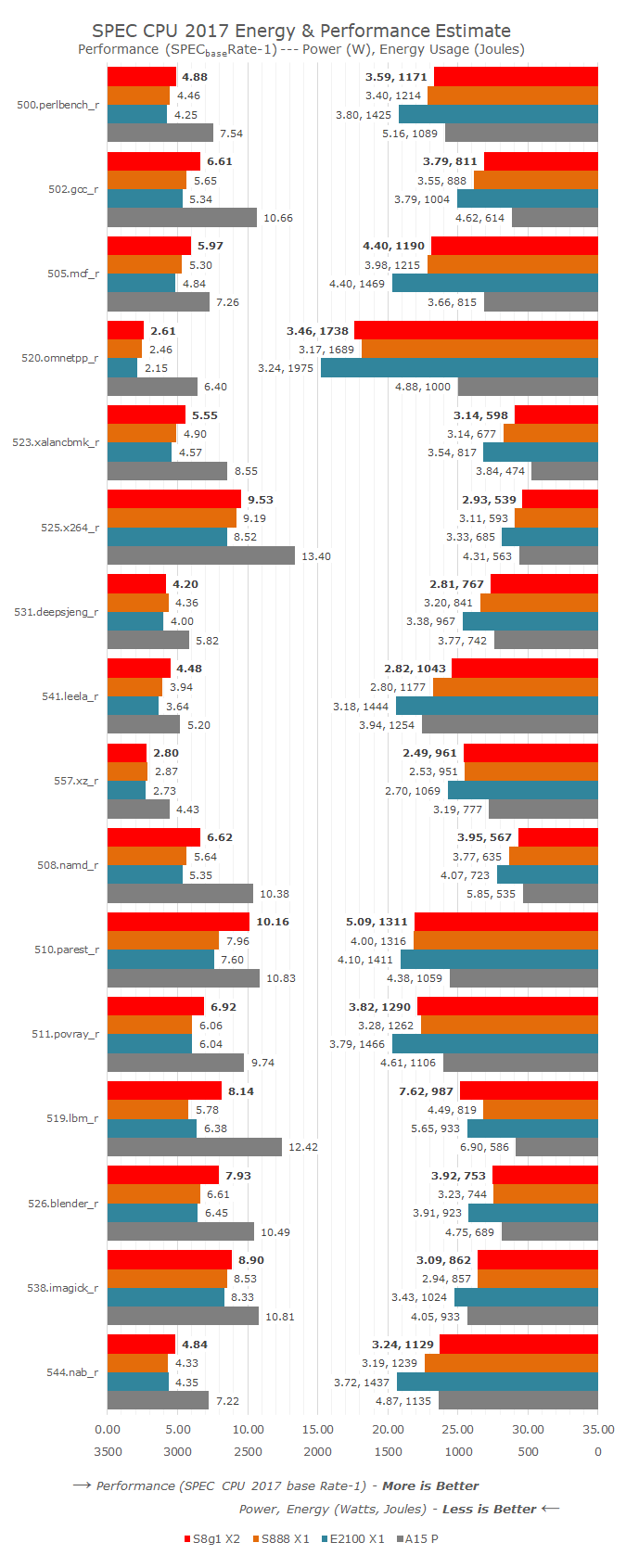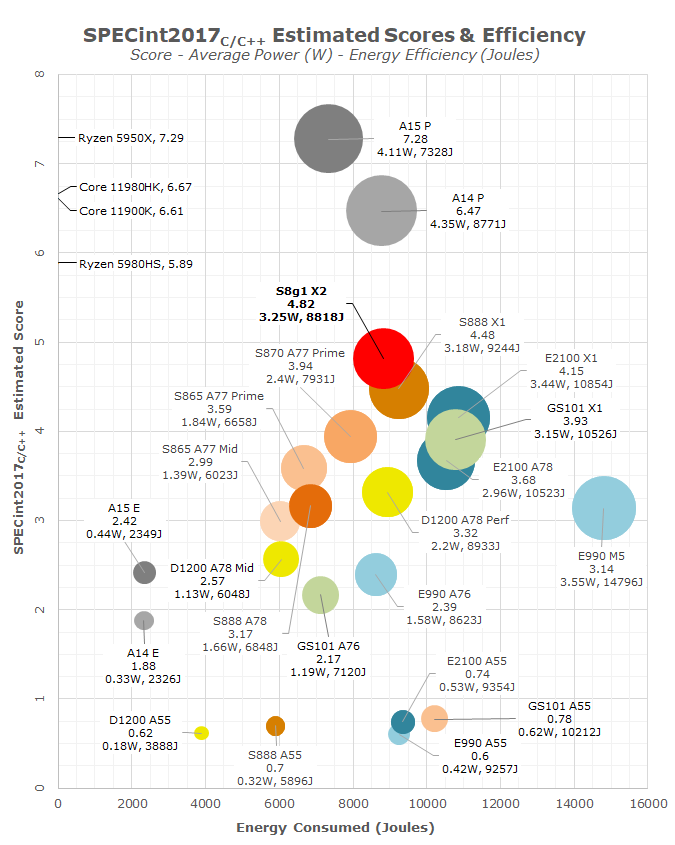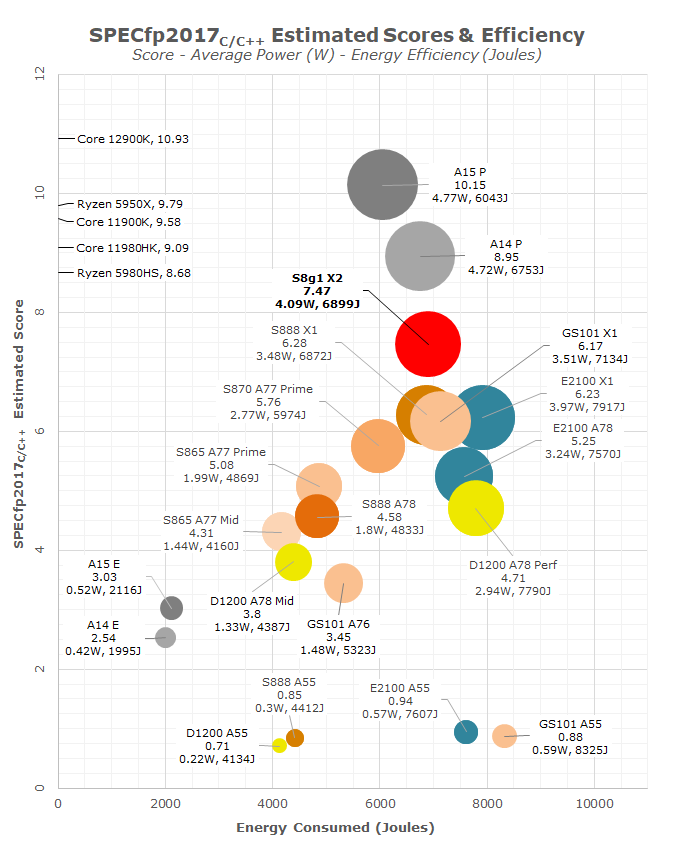The Snapdragon 8 Gen 1 Performance Preview: Sizing Up Cortex-X2
by Dr. Ian Cutress on December 14, 2021 8:00 AM ESTTesting the Cortex-X2: A New Android Flagship Core
Improving on the Cortex-X1 by switching to the Arm v9 architecture and increasing the core resources, both Arm and Qualcomm are keen to promote that the Cortex-X2 offers better performance and responsiveness than previous CPU cores. The small frequency bump from 2.85 GHz to 3.00 GHz will add some of that performance, however the question is always if the new manufacturing process coupled with the frequency increase allows for better power efficiency when running these workloads. Our standard analysis tool here is SPEC2017.
Running through some of these numbers, there are healthy gains to the core, and almost everything has a performance lift.
On the integer side (from 500.perlbench to 557.xr), there are good gains for gcc (+17%), mcf (+13%), xalancbmk (+13%), and leela (+14%), leading to an overall +8% improvement. Most of these integer tests involve cache movement and throughput, and usually gains in sub-tests like gcc can help a wide range of regular user workloads.
Looking at power and energy for the integer benchmarks, we’re seeing the X2 consume more instantaneous power on almost all the tests, but the efficiency is kicking in. That overall 8% performance gain is taking 5% less total energy, but on average requires 2% more peak power.
If we put this core up against all the other performance cores we test, we see that 8% jump in performance for 5% less energy used, and the X2 stands well above the X1 cores of the previous generation, especially those in non-Snapdragon processors. There is still a fundamental step needed to reach the Apple cores, even the previous-generation A14 performance core, which scores 34% higher for the same energy consumed (albeit on average another 34% peak power).
Just on these numbers, Qualcomm’s +20% performance or +30% efficiency doesn’t bare fruit, but the floating point numbers are significantly different.
Several benchmarks in 2017fp are substantially higher on the X2 this generation. +17% on namd for example would point to execution performance increases, but +28% in parest, +41% in lbm and +20% in blender showcases a mix of execution performance and memory performance. Overall we’re seeing +19% performance, which is nearer Qualcomm’s 20% mark. Note that this comes with an almost identical amount of energy consumed relative to the X1 core in the S888, with a difference of just 0.2%.
The major difference however is the average power consumed. For example, our biggest single test gain in 519.lbm is +41%, but where the S888 averages 4.49 watts, the new X2 core averages 7.62 watts. That’s a 70% increase in instantaneous power consumer, and realistically no single core in a modern smartphone should draw that much power. The reason why the power goes this high is because lbm leverages the memory subsystem, especially that 6 MiB L3 cache and relies on the 4 MiB system level cache, all of which consumes power. Overall in the lbm test, the +41% performance costs +20% energy, so efficiency is still +16% in this test. Some of the other tests, such as parest and blender, also follow this pattern.
Comparing against the competition, the X2 core does make a better generation jump when it comes to floating point performance. It will be interesting to see how other processors enable the X2 core, especially MTK’s flagship at slightly higher frequency, on TSMC N4, but also if it has access to a full 14 MiB combination of caches as we suspect, that could bring the power draw during single core use a lot higher. It will be difficult to tease out exactly who wins what where based on implementation vs. process node, but it will be a fun comparison to make when we look purely at the X2 vs. X2 cores.
Unfortunately due to how long SPEC takes to run (1h30 on the X2), we were unable to test on the A710/A510. We’ll have to wait to see when we get a retail unit.













169 Comments
View All Comments
Fulljack - Wednesday, December 15, 2021 - link
resale value is cool and all but not everyone bought a phone to be sold later down the road. just like how some people simply didn't like iOS and it's limitations.michael2k - Thursday, December 16, 2021 - link
Some people use the extended life of an iPhone for other things; that’s part of why they have high resale value.In other words people hand down three year old iPhones to kids or spouses. Some people want to keep their iPhones. Those people, as an example, refusing to let their iPhones go for sale increase the resale price by reducing supply in the face of demand.
iphonebestgamephone - Tuesday, December 14, 2021 - link
Iphones are pretty bad for gaming for more than a few minutes unless you have very low ambient temps or are willing to use a plugged to the wall phone cooler. Something like the redamgic or legion are better for mobile 'gamers'.hemedans - Wednesday, December 15, 2021 - link
I disagree, if you play games get android gaming phones, they can sustain perfomance compare to iphones which throttle a lot and mislead in lot of metrics (like operate in 120fps when you are on menu and drop to 60fps when you fight)Also with Android you get more games options, like now Ps2 emulator has been released, you wont find something like this in ios, also lot of pc games have been ported to Android, you can enjoy them on go.
yankeeDDL - Tuesday, December 14, 2021 - link
As an Android user, the results in Spec CPU 2017 are depressing.In every single test the X2 is far behind A15 (sometimes by nearly 2x) and yet in every single one the A15 uses less power. It is a bloodbath.
I realize the synthetic tests are not necessarily representative of use case, but it sure looks dismal for Qualcomm. They are extraordinarily behind.
Imagine if the next Galaxy S22 would use the A15: it would be 2-3 years ahead of all competition.
The lack of competition in high-end ARM-based CPU is just mind-boggling.
Wrs - Tuesday, December 14, 2021 - link
Yeah it seems very incremental on the CPU. They need a revolution just to catch up. But their GPU and NN seem like bigger leaps. Unfortunately both are more limited use cases - gaming and speech recognition primarily.Kangal - Sunday, December 19, 2021 - link
With the way Qualcomm has followed with the Wattage, they've only been achieving better and better scores at the expense of battery and heat. Basically they've embraced throttling. And that's not an acceptable solution for phones.There's little to no performance difference between the QSD 855 to its siblings*. And that seems to be the case with the new Snapdragon 8gen1 for 2022. The biggest difference I can see is at the highest-end emulation, which is to run the latest console, with the highest graphical title, and scale up resolution as appropriate. Currently, this is the Nintendo Wii, running Metroid 3 Prime, and upscaled to x4 (1440p). On the fastest Android Phones (eg ASUS RoG 5) it runs around 50-60fps depending on the scene. On something like a Samsung S10+ you're instead getting 40-50fps. And the bigger improvement can come from the natural progression of the emulator itself (ie 2018 vs 2021), and by running Mods on it like MMJ. So these things can/do bridge the performance difference that I stated above.
What might be a good argument to be made, is when we get other more powerful/demanding use cases. Such as comparing Nintendo Switch emulation, running desktop programs, or even getting a new AAA-game that was developed for the handheld (eg GTA 6). Anyways, we will see a separation from current performance tier, at the earliest with 2023 using second-generation ARM Europe microarchitecture. Android hasn't quite caught up to Apple A13 levels of performance yet, and that's what I think when we will surpass it (Apple's A14 and A15 aren't that much better than their A13 either).
*855+, 860, 778, 780, 865, 865+, 870, 888, 888+.
Wereweeb - Tuesday, December 14, 2021 - link
When I can use it as a desktop replacement I'll start to care. Until then, all you get with a "muh faster CPU" is your apps take three nanoseconds less time to open.My next phone will be the GAA-FET (3-2nm) successor to the 780G, for the better energy-efficiency. If it takes five years, so be it. I don't game so I don't have a use for X2 cores.
1_rick - Tuesday, December 14, 2021 - link
"When I can use it as a desktop replacement I'll start to care."DeX, dude. It's already good enough for light work.
TheinsanegamerN - Tuesday, December 14, 2021 - link
Also limited to samsung devices. Perhaps Wereweeb has no interest in owning one of their devices. There are many that have no interest in owning a samsung based on past experiences.